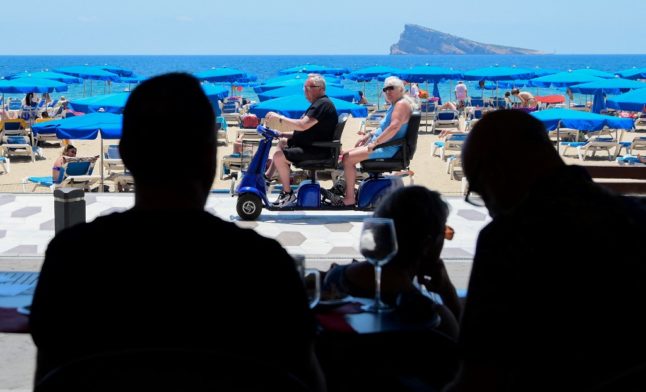“The sound is just amazing. It’s not beautiful, but it’s fascinating,” said biologist Anders Bergström. He leans on a wooden fence that separates visitors from trampled fields where some 10,000 cranes are taking a break.
Up to 25,000 Eurasian cranes – or grus grus, a tall, grey-feathered bird – pass through the wetlands at the southern tip of Lake Hornborga during the first six weeks of Spring, generally starting in mid-March.
An individual crane spends on average 12 days resting here, the final pit stop on a long journey from their winter homes Spain to summer breading grounds in central Sweden and Norway.
At peak periods, some 14,000 cranes – with a record of 18,500 last year – can pack the relatively small feeding area, offering their peculiar song and dance to visitors who themselves flock each year to see the performance.
“They really do dance!” lake visitor and avid bird watcher Lars Lejdegård, 68, said excitedly.
“They jump like that and come down on each other,” said the retired banker, peering up from his tripod-perched monocular to mimic bird movements with his arms.
The “dance” is not as obvious to the untrained – or unequipped – eye, but at any moment pairs of birds can be seen flapping wings, bowing necks, jumping up and down and, at times, throwing grass up in the air.
“It’s not a mating dance,” explained Bergstroem, as cranes don’t perform this ritual once they reach their breeding grounds. Instead, it’s “probably a way to strengthen the social bonds within the pairs.”
The annual spectacle draws up to 150,000 visitors to the lake, in Västra Götaland county, 150 km north-east of Gothenburg. Both average tourists and passionate bird watchers gather to witness the sight. Though most are Swedish or from neighboring Denmark and Norway, some, like Czech national Zdenek Soucek, drive more than 15 hours to witness the gathering.
“In our country, (the cranes) nest, but not so much. It’s a rare kind of bird for us,” said Soucek, in camouflage trousers and gripping a thermos in one hand and a tripod-mounted camera with an impressive telephoto lens in the other. The 57-year-old headmaster and four travel companions have already set up their observation point at 6:30 am to watch the cranes fly in, from their sleeping grounds farther off, to feed in the field.
“All the people coming here, they all have one question in common,” said Claes Hermansson, a 62-year-old local ornithologist and crane specialist. “It is: how many?”
The answer is provided by a 15-member “bird counting team”, of which Hermansson is part. Each day, they send two or three members to an abandoned bus stop on a hilltop near the lake, equipped with monoculars and a crowd counter device.
‘Listen, they are happy’
Alf Karlsson, 75, has been with the team the longest, involved in every crane count since they first started at Hornborga in 1966.
“I don’t know why. I think it’s interesting,” he said, as he, Hermansson and Börje Carlsson, a 79-year-old retired policeman sitting next to Karlsson on the bus stop bench, kept a recent count.
Their tally was 12,200 cranes, with a few more to go.
While local lore says the birds have stopped at Hornborga for thousands of years, their numbers were not always this great.
More and more started flocking to the area in the early 20th century, attracted by the potatoes grown by nearby distilleries and only a day’s flight from their previous stop in northern Germany.
“If cranes find a good spot on the migration route, there’s a good chance they will come back, and they will also bring other cranes with them because cranes are very social,” Bergstroem said.
By the 1950s, Hornborga was attracting about 3,000 cranes annually and gaining fame as a local tourist attraction.
When the distilleries closed, local authorities first kept the potato fields for the cranes, but later switched to spreading barley to save time and labour.
With the barley – today some 140 tonnes are spread each season – came more cranes, more visitors, and the counting began.
On a delicate point, Bergström concedes that feeding the cranes means interfering with nature. “We might affect the migration route,” he said.
But he points out that despite the food and visitors, the cranes are far from tame, insisting they are shy, wild birds not the least interested in their spectators.
Bird counter Hermansson agrees, saying the cranes do not flock to Hornborga to put on a show.
“They need to eat you know,” he said, lifting a hand to his ear. “Listen – they are happy.”



 Please whitelist us to continue reading.
Please whitelist us to continue reading.
Member comments